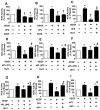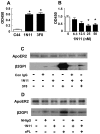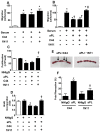Identification of a Monoclonal Antibody That Attenuates Antiphospholipid Syndrome-Related Pregnancy Complications and Thrombosis
- PMID: 27463336
- PMCID: PMC4963039
- DOI: 10.1371/journal.pone.0158757
Identification of a Monoclonal Antibody That Attenuates Antiphospholipid Syndrome-Related Pregnancy Complications and Thrombosis
Abstract
In the antiphospholipid syndrome (APS), patients produce antiphospholipid antibodies (aPL) that promote thrombosis and adverse pregnancy outcomes. Current therapy with anticoagulation is only partially effective and associated with multiple complications. We previously discovered that aPL recognition of cell surface β2-glycoprotein I (β2-GPI) initiates apolipoprotein E receptor 2 (apoER2)-dependent signaling in endothelial cells and in placental trophoblasts that ultimately promotes thrombosis and fetal loss, respectively. Here we sought to identify a monoclonal antibody (mAb) to β2-GPI that negates aPL-induced processes in cell culture and APS disease endpoints in mice. In a screen measuring endothelial NO synthase (eNOS) activity in cultured endothelial cells, we found that whereas aPL inhibit eNOS, the mAb 1N11 does not, and instead 1N11 prevents aPL action. Coimmunoprecipitation studies revealed that 1N11 decreases pathogenic antibody binding to β2-GPI, and it blocks aPL-induced complex formation between β2-GPI and apoER2. 1N11 also prevents aPL antagonism of endothelial cell migration, and in mice it reverses the impairment in reendothelialization caused by aPL, which underlies the non-thrombotic vascular occlusion provoked by disease-causing antibodies. In addition, aPL inhibition of trophoblast proliferation and migration is negated by 1N11, and the more than 6-fold increase in fetal resorption caused by aPL in pregnant mice is prevented by 1N11. Furthermore, the promotion of thrombosis by aPL is negated by 1N11. Thus, 1N11 has been identified as an mAb that attenuates APS-related pregnancy complications and thrombosis in mice. 1N11 may provide an efficacious, mechanism-based therapy to combat the often devastating conditions suffered by APS patients.
Conflict of interest statement
Figures






Similar articles
-
ApoE Receptor 2 Mediation of Trophoblast Dysfunction and Pregnancy Complications Induced by Antiphospholipid Antibodies in Mice.Arthritis Rheumatol. 2016 Mar;68(3):730-739. doi: 10.1002/art.39453. Arthritis Rheumatol. 2016. PMID: 26474194 Free PMC article.
-
Clinical characterization of antiphospholipid syndrome by detection of IgG antibodies against β2 -glycoprotein i domain 1 and domain 4/5: ratio of anti-domain 1 to anti-domain 4/5 as a useful new biomarker for antiphospholipid syndrome.Arthritis Rheumatol. 2015 May;67(8):2196-204. doi: 10.1002/art.39187. Arthritis Rheumatol. 2015. PMID: 25939498
-
Pathogenic role of anti-beta2-glycoprotein I antibodies on human placenta: functional effects related to implantation and roles of heparin.Hum Reprod Update. 2007 Mar-Apr;13(2):189-96. doi: 10.1093/humupd/dml051. Epub 2006 Nov 11. Hum Reprod Update. 2007. PMID: 17099207 Review.
-
Antiphospholipid antibodies promote leukocyte-endothelial cell adhesion and thrombosis in mice by antagonizing eNOS via β2GPI and apoER2.J Clin Invest. 2011 Jan;121(1):120-31. doi: 10.1172/JCI39828. Epub 2010 Dec 1. J Clin Invest. 2011. PMID: 21123944 Free PMC article.
-
Probing antiphospholipid-mediated thrombosis: the interplay between anticardiolipin antibodies and endothelial cells.Lupus. 2003;12(7):539-45. doi: 10.1191/961203303lu398oa. Lupus. 2003. PMID: 12892395 Review.
Cited by
-
Understanding the Pathophysiology of Preeclampsia: Exploring the Role of Antiphospholipid Antibodies and Future Directions.J Clin Med. 2024 May 2;13(9):2668. doi: 10.3390/jcm13092668. J Clin Med. 2024. PMID: 38731197 Free PMC article. Review.
-
Antiphospholipid Antibodies to Domain I of Beta-2-Glycoprotein I Show Different Subclass Predominance in Comparison to Antibodies to Whole Beta-2-glycoprotein I.Front Immunol. 2018 Sep 28;9:2244. doi: 10.3389/fimmu.2018.02244. eCollection 2018. Front Immunol. 2018. PMID: 30323817 Free PMC article.
-
Protein Phosphatase 2A Activation Via ApoER2 in Trophoblasts Drives Preeclampsia in a Mouse Model of the Antiphospholipid Syndrome.Circ Res. 2021 Sep 17;129(7):735-750. doi: 10.1161/CIRCRESAHA.120.318941. Epub 2021 Aug 18. Circ Res. 2021. PMID: 34404233 Free PMC article.
-
Effects of anti-beta 2-glycoprotein 1 antibodies and its association with pregnancy-related morbidity in antiphospholipid syndrome.Am J Reprod Immunol. 2022 Jan;87(1):e13509. doi: 10.1111/aji.13509. Epub 2021 Dec 4. Am J Reprod Immunol. 2022. PMID: 34738282 Free PMC article. Review.
-
Targeting Phosphatidylserine Enhances the Anti-tumor Response to Tumor-Directed Radiation Therapy in a Preclinical Model of Melanoma.Cell Rep. 2021 Jan 12;34(2):108620. doi: 10.1016/j.celrep.2020.108620. Cell Rep. 2021. PMID: 33440157 Free PMC article.
References
-
- Miyakis S, Lockshin MD, Atsumi T, Branch DW, Brey RL, Cervera R et al. International consensus statement on an update of the classification criteria for definite antiphospholipid syndrome (APS). J Thromb.Haemost. 2006;4: 295–306. - PubMed
-
- Levine JS, Branch DW, Rauch J. The antiphospholipid syndrome. N.Engl.J Med. 2002;346: 752–763. - PubMed
MeSH terms
Substances
Grants and funding
LinkOut - more resources
Full Text Sources
Other Literature Sources
Medical
Miscellaneous

